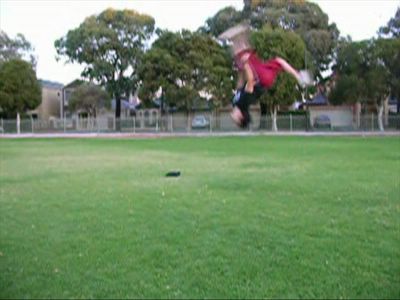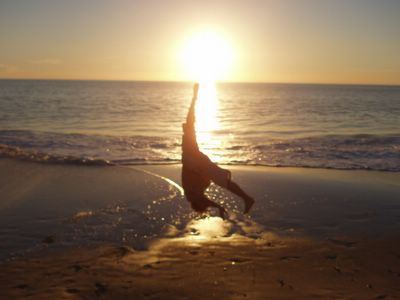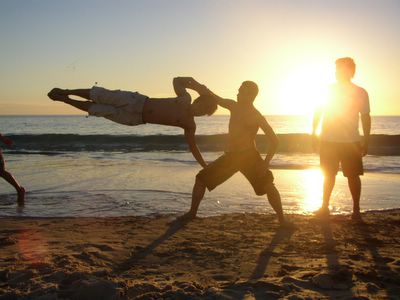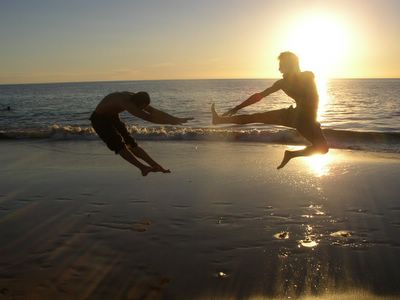Recently I'd just gotten back into training and have been doing the exercises my physio prescribed to me to get my right ankle back into working order. Unfortunately, it seems now my left knee problem has been aggravated, and i think this is due to the training in the gymnastics gym.
I've gotten alot of injuries before, however its strange that this is the only one which i can say has been entirely due to my martial arts training.
A few years back when i was in wushu training i developed what's known as "Jumper's knee" in my left knee. If you think you might have jumper's knee, here is a short description from the
Hughston health alert website:
Patellar tendinitis, also known as jumper's knee, is a relatively common inflammatory condition that causes pain in the anterior (front) aspect of the knee. The extensor mechanism (Fig.), which includes the quadriceps muscle and patellar tendon, connects the patella (kneecap) to the femur (thighbone) and the tibia (shin). Patellar tendinitis begins as inflammation of the patellar tendon where it attaches to the patella. It can also progress by tearing or degeneration of the tendon.

Jumper's knee is an overuse injury that results from repetitive overloading of the extensor mechanism of the knee. Microtears to the patellar tendon often exceed the body's ability to heal the area unless the aggravating activity is stopped for a period of time. Jumper's knee occurs in many types of athletes but is most common in sports such as basketball, volleyball, or soccer, which require explosive jumping movements. Eccentric loading, which is contraction of the muscle while it is lengthening, occurs when landing from a jump or decelerating. In fact, knee loads up to 7 times body weight occur in a soccer player during kicking and between 9 and 11 times body weight occur in volleyball players during landing. These eccentric loads are thought to be the primary cause of overload in jumper's knee.
Patients with jumper's knee have pain in the area of the patellar tendon, usually near its attachment to the patella. It typically starts as a dull ache but can gradually increase over a period of time. Initially, the soreness is usually felt following a game or workout, but as the condition worsens, one may feel stiffness, grinding, and swelling in the knee. From a diagnostic standpoint, the symptoms can be divided into 4 stages. In stage 1, pain occurs only after activity. The condition does not seem to bother the person before or during the activity. In stage 2, pain is present at the beginning of an activity, seems to dissipate after warming up for a while, and then reappears after the activity. In this stage, the athlete's play is not usually affected. In stage 3, pain occurs during and after activity, affecting performance. In stage 4, the tendon ruptures, causing a chronic weakness of the tendon.
From the same site, here is what they recommend in a nutshell if you happen to have any of the four stages of jumper's knee:
Resting the injured area until the symptoms have subsided is very important.
The RICE regimen (rest, ice, compression, elevation) can also help alleviate soreness.
Nonsteroidal anti-inflammatory medication, such as aspirin or ibuprofen, and ice massage after activity can help control the swelling and inflammation.
Strengthening the quadriceps helps to balance the forces across the patella and take pressure off the patellar tendon.
Hamstring stretching is extremely important to take pressure off the anterior structures of the knee.
Once the inflammation is controlled, the patient with mild to moderate jumper's knee can begin an exercise program focusing on eccentric strengthening exercises.
Neoprene sleeves or braces similar to the ones worn by tennis players with tennis elbow can help decrease or disperse the forces on the patella.
The outcome of treatment in patients with jumper's knee is usually very good, especially for those patients in stage 1 and 2, Sometimes in stage 3, the nature of the injury and how it will respond to nonoperative treatment are a little more unpredictable.
Even so, few of these patients go on to require surgical intervention.
Surgery is reserved for patients who experience debilitating pain for 6 to 12 months despite close adherence to their doctor's instructions.
Patients with stage 4 disease who have suffered a complete tendon rupture also need surgery.
The overall goal of surgery is to remove the damaged tissue from the tendon and stimulate blood flow to promote healing.
Maximizing quadriceps and hamstring muscle strength and flexibility is the best way to prevent knee injury.
Preseason conditioning should concentrate on a gradual increase in repetitive eccentric quadriceps contraction so the tendon can begin to withstand repetitive loading.
These measures will help to prevent this inflammatory process.
As always, the best treatment is prevention.
 Firstly, start off standing as upright as possible with your foot and knee planted against a wall parallel to the ground. Even if it is not exactly parallel, try and get it as parallel as possible.
Firstly, start off standing as upright as possible with your foot and knee planted against a wall parallel to the ground. Even if it is not exactly parallel, try and get it as parallel as possible. The distance between your legs should be approximately shoulder width, with the knee and foot of the standing leg being in a straight line with each other as in the above image. The other leg which is leaning on the wall is bent slightly at an angle to create leverage so you dont just slide down the wall. However, don't place your leg too high up on the wall. You want your leaning knee to be only slightly higher than your standing knee.
The distance between your legs should be approximately shoulder width, with the knee and foot of the standing leg being in a straight line with each other as in the above image. The other leg which is leaning on the wall is bent slightly at an angle to create leverage so you dont just slide down the wall. However, don't place your leg too high up on the wall. You want your leaning knee to be only slightly higher than your standing knee. Once you are ready and are in position, perform a squat by pushing your bum down and backwards whilst leaning forward like you're riding a horse or about to fire a rocket out your ass. Keep your back straight by looking forward. After the squat, return to starting position as shown in the first image.
Once you are ready and are in position, perform a squat by pushing your bum down and backwards whilst leaning forward like you're riding a horse or about to fire a rocket out your ass. Keep your back straight by looking forward. After the squat, return to starting position as shown in the first image. 




